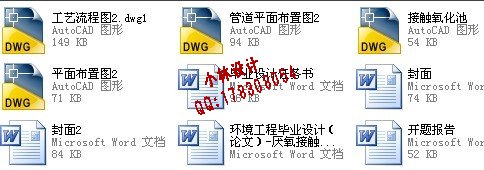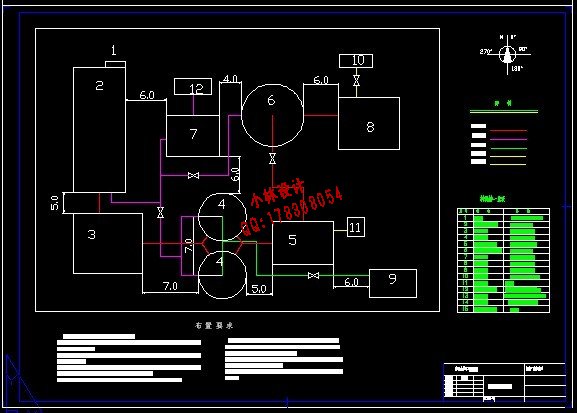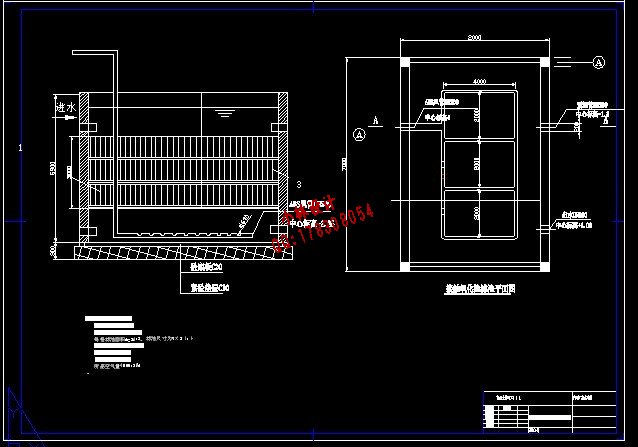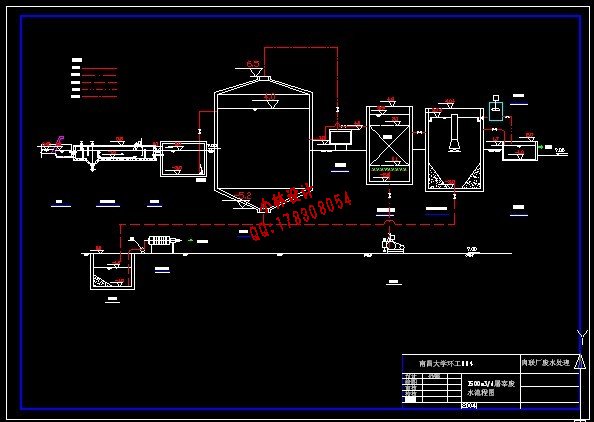|
设计简介 |
设计描述:
Word版说明书一份,27页,14000字左右.
外文翻译一份
CAD版本图纸,共4张:
目 录
摘要…………………………………………………………………………………2
Abstract……………………………………………………………………………2
第一章 前言
一、 设计内容………………………………………………………………………4
二、 设计依据………………………………………………………………………4
第二章 处理方案论证
一、 国内外方法综述…………………………………………………………………5
二、 接触氧化法介绍…………………………………………………………………7
第三章 工艺设计
一、 工艺流程…………………………………………………………………………9
二、 构筑物及设备……………………………………………………………………9
㈠ 格栅………………………………………………………………………………9
㈡ 初沉隔油池……………………………………………………………………11
㈢ 调节池…………………………………………………………………………13
㈣ 厌氧池…………………………………………………………………………13
㈤ 接触氧化池……………………………………………………………………15
㈥ 竖流式二沉池…………………………………………………………………18
㈦ 污泥池…………………………………………………………………………20
㈧ 清水池…………………………………………………………………………11
㈨ 设备选型………………………………………………………………………21
第四章 平面布置、高程布置与管路布置
一、平面布置、高程布置与管路布置…………………………………………………22
㈠ 平面布置………………………………………………………………………23
㈡ 高程布置………………………………………………………………………24
㈢ 管道布置………………………………………………………………………25
第五章 技术经济分析
一、 费用计算…………………………………………………………………………25
㈠ 构筑物基建费用………………………………………………………………25
㈡ 设备、管件及材料费用…………………………………………………………25
㈢ 其他费用………………………………………………………………………26
第六章 结束语……………………………………………………………………27
摘 要
某屠宰厂日排水量为1500 m3/d,废水中含有血污、油脂、粪便、皮、毛和猪肠胃食物残渣等,属中等浓度有机废水。经对此废水进行分析比较后,选定了生物接触氧化法对其处理。
生物接触氧化法于1971年在日本首创,近年来,该技术在国内都得到了较为广泛的研究与应用,用于处理生活污水和某些工业有机废水,并取得了良好的处理效果。
生物接触氧化池内设置填料,填料浸没在废水中,填料上长满生物膜,废水与生物膜接触的过程中,水中的有机物被微生物吸附、氧化分解和转化为新的生物膜。从填料上脱落的生物膜,随水流到二沉池后被去除,废水得到净化。生物接触氧化法兼有生物膜法和活性污泥法的优点,净化效率高,处理时间短,对进水有机负荷的变动适应性强,不需要污泥回流,没有污泥膨胀问题,管理方便,占地面积小等。
通过对各构筑物的计算,最终得出BOD5和COD的出水分别为10 mg/L和30 mg/L,均超过了国家的相关排放标准,可直接排放。
关键词: 屠宰废水 生物接触氧化法 BOD CODcr
ABSTRCT
Summary some slaughter house day displacement for 1500 m3/d, waste water contain blood stains , oil , excrement and urine , skin , pig stomach food residue ,etc., belong to the organic waste water of medium-sized density. Through is it is it after comparing , select to waste water this living beings is it oxidize law deal with it to exposed to analyze to go on.
Living beings is it oxidize law initiate in Japan on 1971 , in recent years , technology this it gets to be comparatively extensive study and application at home to exposed to, used for dealing with the sanitary sewage and organic waste water of some industry, has made the good treatment result.
The living beings contact and oxidize and set up the packing in the pool, the packing submergence is covered with the bio-membrane on the packing in the waste water, waste water, and among the course that bio-membrane contact, organic matter of water absorb , is it resolve and turned microorganism into the new bio-membrane to oxidize. The bio-membrane coming off from packing , as the rivers is got rid of after two sinks the pool, the waste water is purified
It has biological embraced method and advantage of the active mud law concurrently that the living beings are exposed to the law of oxidizing, it is with high efficiency to purify , deal with time short , have a good adaptability to the change which enters the organic load of water, not needing mud backset current , there is no mud to expand questions, management is convenient, the floor space is smallness.
Through to all structures of calculations , must appear BOD5 and COD it surfaces to be 10 mg/L and 30 mg/L respectively finally, exceed the relevant discharge standards of the country , can discharge directly
Keyword: Slaughter-house water Bio-membrane BOD CODcr
第一章 前言
一、设计内容
肉联厂废水处理主要是屠宰水,屠宰车间为非连续性生产,每天只有一班,废水排放主要集中在凌晨3~6小时,废水流量变化较大。生产具有明显的季节性,为此,废水的日排放量在一年之中变化也较大。废水主要含有血污、油脂、粪便、皮、毛和猪肠胃食物残渣等,属中等浓度有机废水。可生化性较好,但废水中也含有许多难降解的血红蛋白及其他高分子有机物,废水中总氮浓度高。
目前,随着人们生活水平的不断提高屠宰场的规模也在不断扩大,屠宰废水的排放量越来越大,必须进行处理。对有机废水的处理多采用生化法,主要有好氧处理法,厌氧生物处理法以及好氧-厌氧组合处理法。针对现废水排放情况,要求运用合适的废水处理及其配套工艺对屠宰废水进行处理,优化最佳工艺条件。并要求处理后的废水达到国家二级排放标准。
|










